As others have said, the easy short answer is: No, it is not more random, but it does change the distribution.
Suppose you were playing a dice game. You have some completely fair, random dice. Would the die rolls be "more random" if before each die roll, you first put two dice in a bowl, shook it around, picked one of the dice at random, and then rolled that one? Clearly it would make no difference. If both dice give random numbers, then randomly choosing one of the two dice will make no difference. Either way you'll get a random number between 1 and 6 with even distribution over a sufficient number of rolls.
I suppose in real life such a procedure might be useful if you suspected that the dice might NOT be fair. If, say, the dice are slightly unbalanced so one tends to give 1 more often than 1/6 of the time, and another tends to give 6 unusually often, then randomly choosing between the two would tend to obscure the bias. (Though in this case, 1 and 6 would still come up more than 2, 3, 4, and 5. Well, I guess depending on the nature of the imbalance.)
There are many definitions of randomness. One definition of a random series is that it is a series of numbers produced by a random process. By this definition, if I roll a fair die 5 times and get the numbers 2, 4, 3, 2, 5, that is a random series. If I then roll that same fair die 5 more times and get 1, 1, 1, 1, 1, then that is also a random series.
Several posters have pointed out that random functions on a computer are not truly random but rather pseudo-random, and that if you know the algorithm and the seed they are completely predictable. This is true, but most of the time completely irrelevant. If I shuffle a deck of cards and then turn them over one at a time, this should be a random series. If someone peeks at the cards, the result will be completely predictable, but by most definitions of randomness this will not make it less random. If the series passes statistical tests of randomness, the fact that I peeked at the cards will not change that fact. In practice, if we are gambling large sums of money on your ability to guess the next card, then the fact that you peeked at the cards is highly relevant. If we are using the series to simulate the menu picks of visitors to our web site in order to test the performance of the system, then the fact that you peeked will make no difference at all. (As long as you do not modify the program to take advantage of this knowledge.)
EDIT
I don't think I could my response to the Monty Hall problem into a comment, so I'll update my answer.
For those who didn't read Belisarius link, the gist of it is: A game show contestant is given a choice of 3 doors. Behind one is a valuable prize, behind the others something worthless. He picks door #1. Before revealing whether it is a winner or a loser, the host opens door #3 to reveal that it is a loser. He then gives the contestant the opportunity to switch to door #2. Should the contestant do this or not?
The answer, which offends many people's intuition, is that he should switch. The probability that his original pick was the winner is 1/3, that the other door is the winner is 2/3. My initial intuition, along with that of many other people, is that there would be no gain in switching, that the odds have just been changed to 50:50.
After all, suppose that someone switched on the TV just after the host opened the losing door. That person would see two remaining closed doors. Assuming he knows the nature of the game, he would say that there is a 1/2 chance of each door hiding the prize. How can the odds for the viewer be 1/2 : 1/2 while the odds for the contestant are 1/3 : 2/3 ?
I really had to think about this to beat my intuition into shape. To get a handle on it, understand that when we talk about probabilities in a problem like this, we mean, the probability you assign given the available information. To a member of the crew who put the prize behind, say, door #1, the probability that the prize is behind door #1 is 100% and the probability that it is behind either of the other two doors is zero.
The crew member's odds are different than the contestant's odds because he knows something the contestant doesn't, namely, which door he put the prize behind. Likewise, the contestent's odds are different than the viewer's odds because he knows something that the viewer doesn't, namely, which door he initially picked. This is not irrelevant, because the host's choice of which door to open is not random. He will not open the door the contestant picked, and he will not open the door that hides the prize. If these are the same door, that leaves him two choices. If they are different doors, that leaves only one.
So how do we come up with 1/3 and 2/3 ? When the contestant originally picked a door, he had a 1/3 chance of picking the winner. I think that much is obvious. That means there was a 2/3 chance that one of the other doors is the winner. If the host game him the opportunity to switch without giving any additional information, there would be no gain. Again, this should be obvious. But one way to look at it is to say that there is a 2/3 chance that he would win by switching. But he has 2 alternatives. So each one has only 2/3 divided by 2 = 1/3 chance of being the winner, which is no better than his original pick. Of course we already knew the final result, this just calculates it a different way.
But now the host reveals that one of those two choices is not the winner. So of the 2/3 chance that a door he didn't pick is the winner, he now knows that 1 of the 2 alternatives isn't it. The other might or might not be. So he no longer has 2/3 dividied by 2. He has zero for the open door and 2/3 for the closed door.






